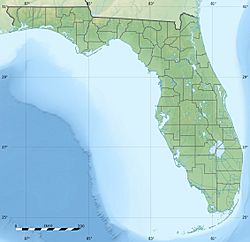Atsena Otie Key facts for kids

Atsena Otie Key
|
|
| Geography | |
|---|---|
| Coordinates | 29°07′25.6″N 83°01′51.6″W / 29.123778°N 83.031000°W |
| Adjacent bodies of water | Gulf of Mexico |
| Administration | |
| State | Florida |
| County | Levy |
Atsena Otie Key is a small barrier island located about half a mile from Cedar Key, Florida. It was once the original site of the town of Cedar Key. Today, the island has a walking trail, a swimming area, and the remains of an old pencil factory. Atsena Otie Key is part of the Cedar Key National Wildlife Refuge. The U.S. Fish and Wildlife Service helps manage this special place.
Contents
History of Atsena Otie Key
Early Times on the Island
In 1999, a very old skeleton was found on Atsena Otie Key. Scientists believe it is more than 2,000 years old. This shows that Native Americans lived on the island a very long time ago.
When Spanish explorers arrived in the early 1500s, they brought new diseases. Sadly, many native people on the island died from these illnesses. By the 1800s, most of the remaining native people had to move away.
Wars and a New Name
From 1818 to the early 1820s, Atsena Otie Key was an important trading spot. It played a role during the First Seminole War. Florida became a U.S. Territory in 1821.
During the Second Seminole War in 1840, the U.S. Army built a hospital on the island. It became the Army's main base in Florida and was called Depot Key. In 1842, a U.S. Army commander met with Seminole leaders on Depot Key. They agreed that if the Seminoles stayed in southern Florida, the Army would leave them alone. This agreement helped end the Second Seminole War.
Later in 1842, a powerful hurricane hit Depot Key. It caused so much damage that the Army left the island.
Growing as a Town
In 1843, a man named Augustus Steele claimed Depot Key. He renamed it Atsena Otie Key. He built summer homes for rich families from Florida and Georgia. The meaning of "Atsena Otie" is not fully known. In 1845, the Cedar Key Post Office opened, with Augustus Steele as the first postmaster.
During the 1850s, trade grew on the island. A lighthouse was built nearby on Seahorse Key in 1854 to guide ships. The Florida Railroad reached the Cedar Keys area in 1861. A train station was built on Way Key, which is north of Atsena Otie Key.
In 1855, the A. W. Faber company bought land in Levy County. They planned to cut down trees for timber. In 1856, they bought a small piece of land on Atsena Otie Key for a lumber mill. In 1858, Atsena Otie officially became a town. By 1860, about 215 people lived there.
The Civil War Years
The American Civil War (1861-1865) brought tough times to Atsena Otie Key. The Union Navy blocked the harbor, stopping ships and fishing.
The Battle of Cedar Key
On January 7, 1862, a Union Navy ship, the USS Hatteras, attacked the railroad station. They destroyed tracks, engines, and buildings. The Hatteras then sank or burned seven ships in the harbor at Depot Key. This event is known as the Battle of Cedar Key.
The USS Somerset
Another Union ship, the USS Somerset, captured a ship called Curlew near Atsena Otie Key in June 1862. Later, in October, the Somerset destroyed salt works on James Island, near Depot Key. Salt was very important back then for preserving food. The Union sailors destroyed a lot of salt and captured many workers.
Rebuilding and Growth
After the Civil War, the Eberhard Faber Pencil Company built a large lumber mill on Atsena Otie Key in 1868. This mill provided wood for their pencil factory in New Jersey. The area became a busy shipping port again, and a lot of lumber was processed.
By the 1870s, industries like oyster harvesting, green turtle fishing, and general fishing also grew on the island. By the 1890s, the lumber business was very profitable. The Faber Mill alone produced enough wood for hundreds of thousands of pencils. The town grew, and by 1895, over 50 families lived on the island.
The Great Hurricane of 1896
On September 29, 1896, a very powerful hurricane hit Atsena Otie Key. A 10-foot storm surge (a wall of water) swept over the island. The Eberhard Faber mill was completely destroyed, and most of the island was ruined.
The cedar forests that supplied the mills were mostly cut down by then. So, the mill companies decided not to rebuild. Some buildings and houses that survived were floated across the water to Cedar Key (which was formerly Way Key). Lumber from the destroyed mills was used to build new structures on Cedar Key.
Most people moved from Atsena Otie Key to Cedar Key after the hurricane. However, some stayed into the 1900s. The last wooden house on the island was taken down in the 1940s, and its wood was also moved to Cedar Key.
Atsena Otie Key Today
In 1923, Atsena Otie Key was bought for $500. In 1929, the Cedar Keys National Wildlife Refuge was created on nearby islands like Snake, Bird, and North Keys.
In 1950, the last remaining house on Atsena Otie Key was destroyed by Hurricane Easy.
In 1997, the Suwannee River Water Management District bought Atsena Otie Key. They made an agreement with the U.S. Fish and Wildlife Service to manage the island. Today, Atsena Otie Key is open for everyone to visit and enjoy.
Images for kids







